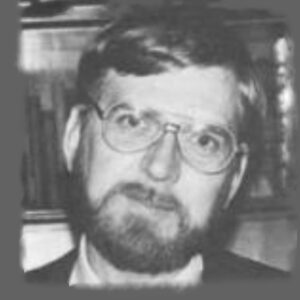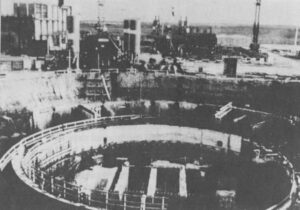Ron Wolf
- 1981

Fellowship Title:
- Safeguarding Nuclear Materials
Fellowship Year:
- 1981

Diversions and Alarms
RICHLAND, WA–Most people involved in safeguarding the U.S. nuclear industry from the theft or diversion of materials were barely aware until last year of the plant operated here by the Exxon Nuclear Company. Now they are paying much closer attention to the events unfolding at Richland. For the first time, a U.S. nuclear facility is coming under the same international controls that are applied routinely to hundreds of other installations throughout the world. The procedures being implemented here are part of the controversial monitoring system that is supposed to prevent the spread of nuclear weapons by detecting the misuse of normally peaceful commercial nuclear facilities. The adequacy of these safeguards and the effectiveness of the International Atomic Energy Agency which administers them increasingly are being called into question at the highest levels of the U.S. government. Congress, the State Department, the Nuclear Regulatory Commission and the National Security Council are all engaged in this ongoing debate, a process which is likely to reshape American policy toward the export of sensitive nuclear technology and materials. At

Cornerback Security
WASHINGTON, DC–A color slide of the distinctive mushroom-shaped cloud produced by a nuclear explosion flashed on the screen as L.D.Y. Ong began his presentation–the eighth technical paper of the morning. Several of the seventy scientists and engineers sandwiched into the darkened hotel meeting room grumbled as four more examples of the same awesome sight appeared before them. “Cookie” Ong, a policy analyst for the Nuclear Regulatory Commission, noted that there had been about seven thousand incidents of terrorism worldwide in the past dozen years. These grim pictures, he explained, might serve a simple but persuasive incentive in carrying on the fight against the ultimate form of terrorism and violence: nuclear destruction Rocky Flats nuclear plant. The listeners, composed almost entirely of people from the nuclear industry, seemed to feel that they needed no such obvious reminder of their solemn mission. The attendees at this three-day symposium in San Francisco last summer were all “safeguarders,” members of the little-known Institute of Nuclear Materials Management. The 23-year-old professional organization is composed of more than seven hundred specialists

Letter From Los Alamos
LOS ALAMOS, NM–I have successfully infiltrated a government nuclear-fuel reprocessing plant. The next order of business is to steal enough plutonium to manufacture a small, low-yield nuclear weapon. Getting it out the door is a snap. Despite their expensive detection equipment, random searches and other precautions, the guards are letting me walk off with all I need–just eight kilograms (171/2 pounds). The last obstacle is the automated accounting system, a small computer that monitors the quantity of plutonium moving through the purification process and records the balance on hand at the end of each shift. Unfortunately for the government, this operation isn’t like a bank where the auditors can count the money right down to the last penny. They’re lucky if they come within half a percent. Consequently, the books never quite balance from day to day. The amount of plutonium in the storage tanks, mixing vats and other plumbing can only be estimated. Fluctuations in inventory are common. “Technicians at the Los Alamos National Laboratory must give instructions to a computer (terminal in foreground)

Locking the Barn Door? Safeguarding Nuclear Facilities
DENVER–From a distance, the high chain-link fence surrounding the Rocky Flats Plant looked like the perimeter of any other large, Security-conscious factory. Ten feet inside the main entrance, in a small cinderblock building at the side of the road, sat several uniform guards. For the most part, their duties on this March morning consisted of processing the few visitors who had official business at the government owned nuclear plant. About mid-morning, they opened the remotely-operated industrial gate to admit a technician who had been hired by a subcontractor to inspect a construction project. As the technician’s truck passed the guard post and turned toward the project, yellow lights on the roof of the building and the gate began to flash. A loud warbling horn pierced the silence, even scaring the guards. Immediately, the heavy gate was slammed shut, blocking the exit road. The alarm was instantly relayed to a central command post hidden away in the most secure part of the complex. From there, armed reinforcements were dispatched to track down the suspicious truck and

On the Road with Plutonium
DENVER–The temperature was in the 20’s this December day and light snow was expected as Jonny Sappington pulled his government-owned 18-wheeler out of Cheyenne after lunch. He headed south toward Denver with his highly classified cargo. Three heavily armed guards followed close behind in a light blue, unmarked Chevrolet Blazer. Two more armed men were in the tractor with him and shared the driving duties since the crew left Richland, Washington, early the previous day. Despite the threatening forecast and overcast skies, the interstate was still clear and dry, at least for another 40 miles. As Sappington neared Fort Collins, Colorado, the condition of the road rapidly worsened. Fog hung in the low-lying areas along the highway, condensing and freezing – coating the pavement with a thick sheet of ice. Sappington slowed his rig as he encountered the first large patch. Moments later, he spotted a truck that had overturned about 400 yards ahead. He applied his brakes and tried to avoid the obstruction, but his truck slowly jack-knifed and slid onto the median strip.
